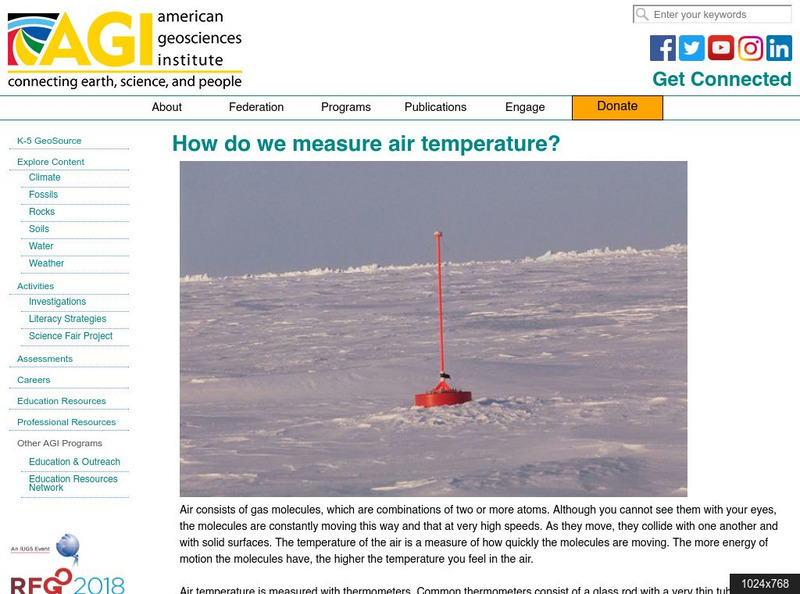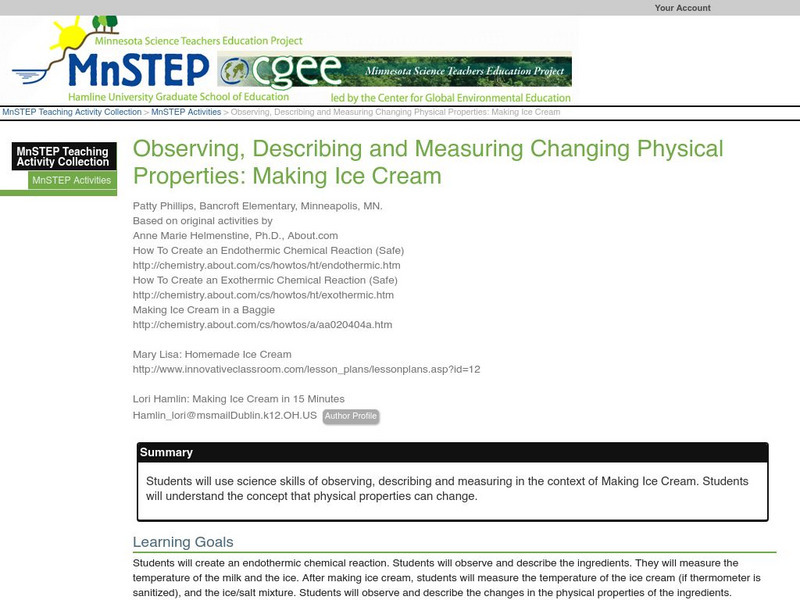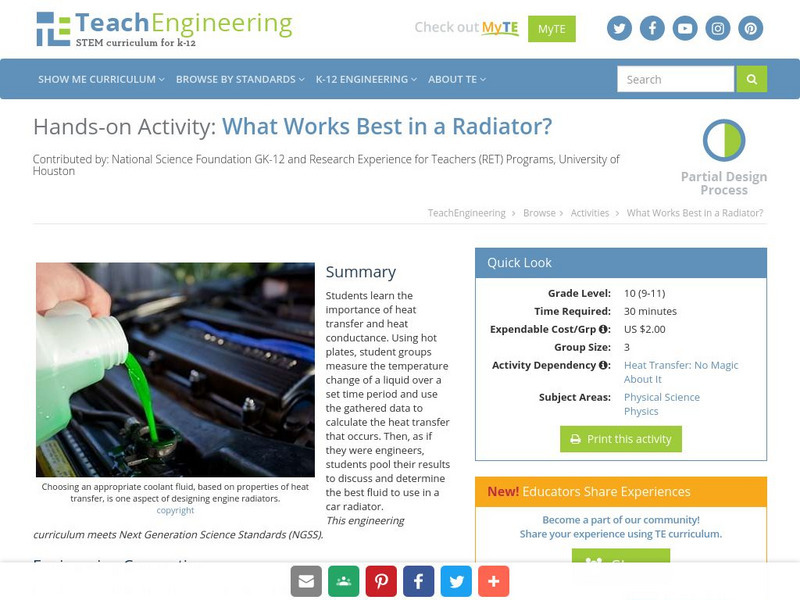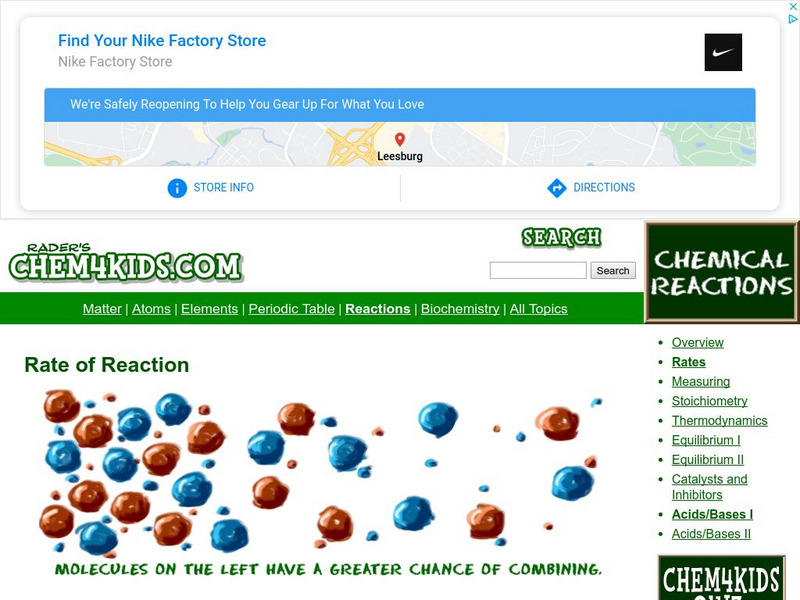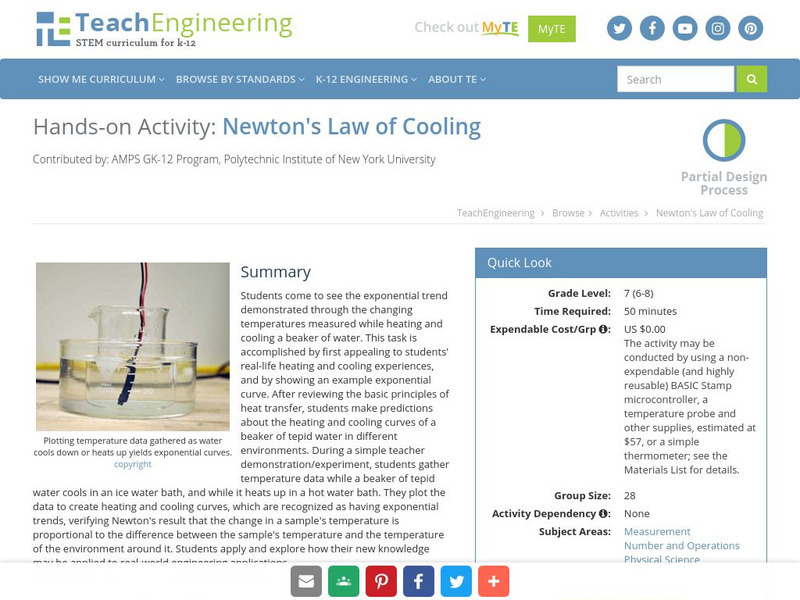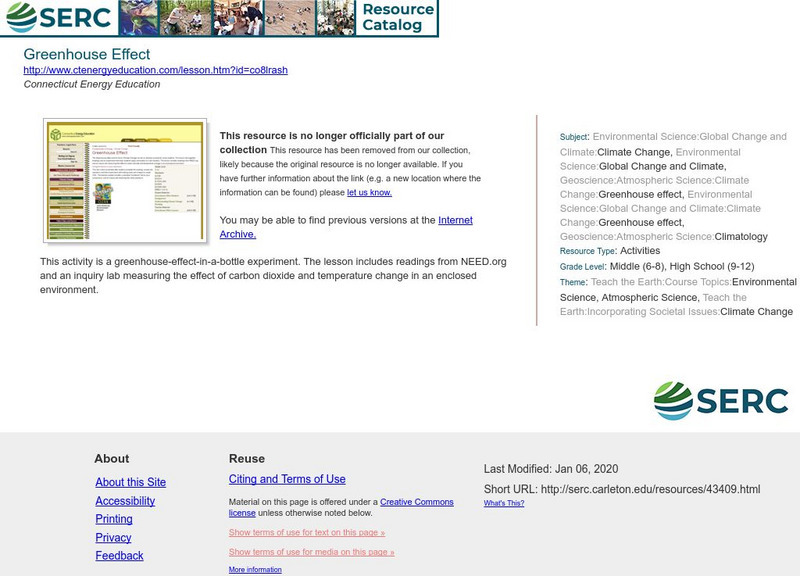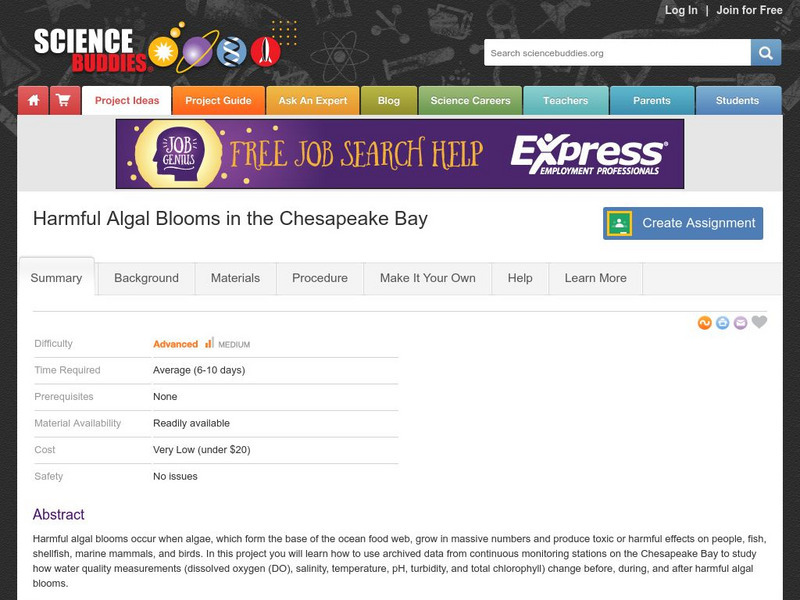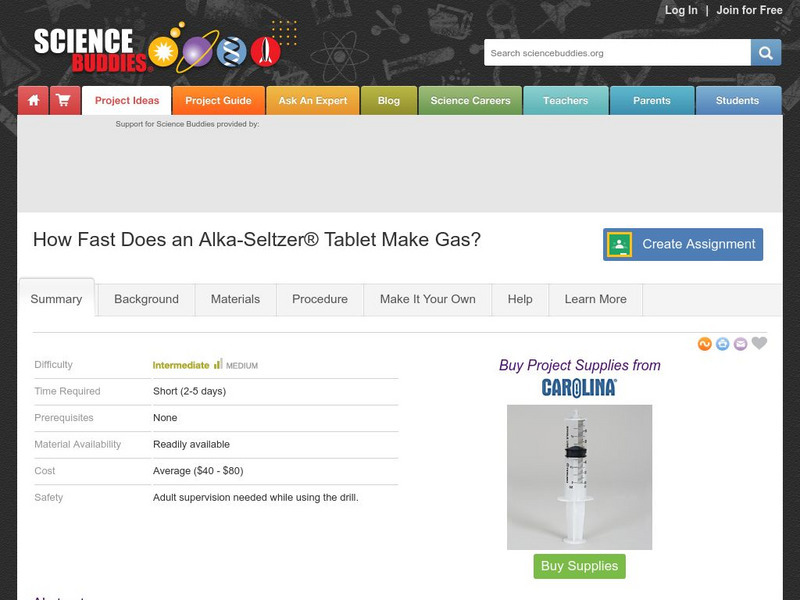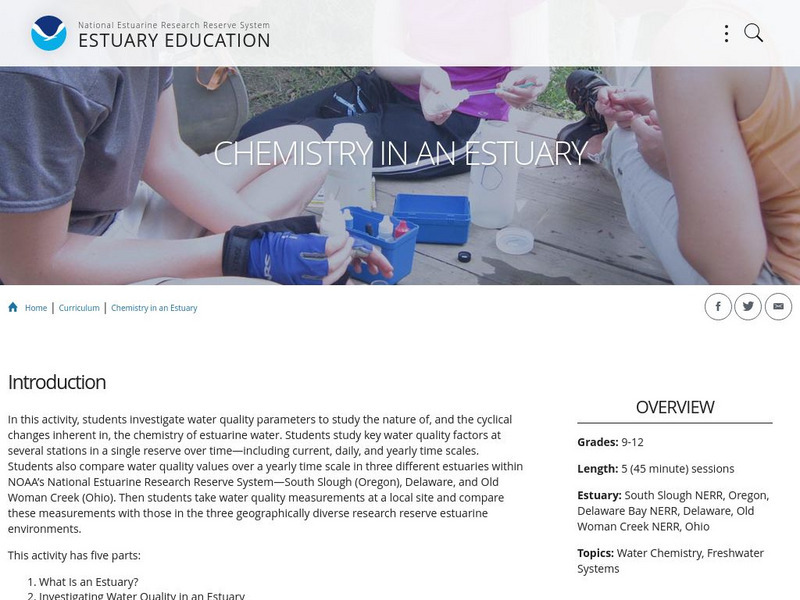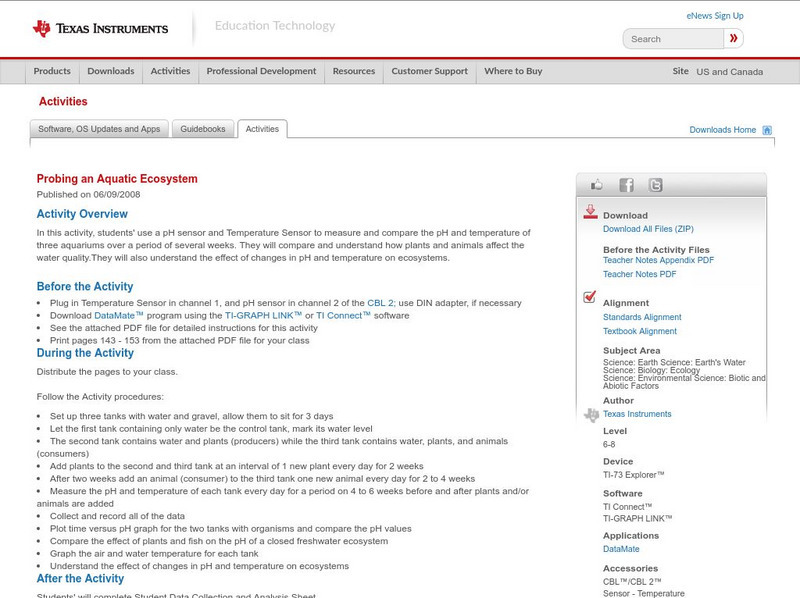Hi, what do you want to do?
TeachEngineering
Teach Engineering: Efficiency of a Water Heating System
Students use a watt meter to measure energy input into a hot plate or hot pot used to heat water. The theoretical amount of energy required to raise the water by the measure temperature change is calculated and compared to the electrical...
American Geosciences Institute
American Geosciences Institute: How Do We Measure Air Temperature?
Find out how scientists measure the air temperature to accurately report the weather.
Science Education Resource Center at Carleton College
Serc: Observing,describing, Measuring Changing Physical Prop: Making Ice Cream
Students will create an endothermic chemical reaction by making ice cream. They will observe, describe, and measure the ingredients. After making ice cream, students will measure the temperature of the ice cream and the ice/salt mixture....
Science Education Resource Center at Carleton College
Serc: Precision in Measurement Finding When an Object Changes Color
This activity is an introduction to measurement, especially precision. Young scholars should know the difference between precision and accuracy in measurement. They will be able to answer the questions: At what temperature does the mood...
Science Buddies
Science Buddies: I'm Trying to Breathe Here! Dissolved Oxygen vs. Temperature
To survive, we need oxygen in the air we breathe. Oxygen is also essential for most aquatic organisms, but there is much less oxygen available in water than in air. Learn how to measure dissolved oxygen and then see how oxygen...
TeachEngineering
Teach Engineering: What Works Best in a Radiator?
Students learn the importance of heat transfer and heat conductance. Using hot plates, student groups measure the temperature change of a liquid over a set time period and use the gathered data to calculate the heat transfer that occurs....
Chem4kids
Chem4 Kids: Reaction Rates
This Chem4Kids.com site explores the rate of reactions. Content focuses on forces that change the speed of reactions, and measuring rates.
Georgia State University
Georgia State University: Hyper Physics: Heat of Fusion
The heat of fusion is defined and described. A graphical representation of the heat of vaporization is given. A method for measuring and calculating the heat of fusion is also presented and explained.
Creative Science Centre
Creative Science Centre: An Electric Thermometer
Instructions for how to make an electrical thermometer. The electrical thermometer works like this - the design consists of four resistors each made from about 40 meters of very thin copper wire. The electrical resistance of wire changes...
TeachEngineering
Teach Engineering: Newton's Law of Cooling
Students come to see the exponential trend demonstrated through the changing temperatures measured while heating and cooling a beaker of water. This task is accomplished by first appealing to students' real-life heating and cooling...
Texas Instruments
Texas Instruments: Designing Hot and Cold Packs
in this activity, students calculate the molar enthalpy of dissolving for three ionic solids, and use this information to design a cold pack. In this experiment they measure the heat changes which occur from various salts dissolving in...
Texas Instruments
Texas Instruments: Heat Transfer by Conduction
The purpose of this activity is to monitor the transfer of heat between 2 materials by measuring the temperature changes in them.
Science Education Resource Center at Carleton College
Serc: Greenhouse Effect
An inquiry lab measuring the effect of carbon dioxide and temperature change in an enclosed environment to simulate the greenhouse effect.
TeachEngineering
Teach Engineering: Weather Basics
Students are introduced to the basics of the Earth's weather. Concepts include fundamental causes of common weather phenomena such as temperature changes, wind, clouds, rain and snow. The different factors that affect the weather and the...
Texas Instruments
Texas Instruments: Who Says a Watched Pot Never Boils?
In this activity, students' will investigate what causes phase changes in matter.They use a temperature sensor to measure the temperature of a substance and identify visual clues to the phase changes.
Science Education Resource Center at Carleton College
Serc: Whither Arctic Sea Ice?
In this lesson young scholars will access and analyze sea ice data. By the end of the lesson students should be able to measure the seasonal variations in sea ice extent, discover long-term changes occurring in sea ice extent, visualize...
Science Education Resource Center at Carleton College
Serc: Mn Step: Why Are There Seasons? A Study of Phenology
This is an ongoing activity where students take monthly temperature measurements, and make observations of the weather and changes in the environment, at the same location in the schoolyard each time. They will make and use an astrolabe,...
TED Talks
Ted: Ted Ed: Is Our Climate Headed for a Mathematical Tipping Point?
Scientists have warned that as CO2 levels in the atmosphere rise an increase in Earth's temperature by even two degrees could lead to catastrophic effects across the world. But how can such a tiny, measurable change in one factor lead to...
University of Colorado
University of Colorado: Ph Et Interactive Simulations: University of Colorado: Gas Properties
Pump gas molecules to a box and see what happens as the volume changes, add or remove heat, change gravity, and more. Measure the temperature and pressure, and discover how the properties of the gas vary in relation to each other....
Science Buddies
Science Buddies: Harmful Algal Blooms in the Chesapeake Bay
Harmful algal blooms occur when algae, which form the base of the ocean food web, grow in massive numbers and produce toxic or harmful effects on people, fish, shellfish, marine mammals, and birds. In this project you will learn how to...
Science Buddies
Science Buddies: How Fast Does an Alka Seltzer Tablet Make Gas?
This is a straightforward, fun project to measure the rate of the chemical reaction that occurs when Alka-Seltzer tablets are plopped into water. You'll track the volume of carbon dioxide gas produced at regular intervals after the...
NOAA
Noaa: Estuaries 101 Curriculum: Chemistry in an Estuary
This activity introduces students to the complex chemistry of estuarine water. Students investigate how chemical and physical water quality factors-pH, temperature, dissolved oxygen, and salinity-change and interact over varying time...
Texas Instruments
Texas Instruments: Probing an Aquatic Ecosystem
In this activity, students' use a pH sensor and Temperature Sensor to measure and compare the pH and temperature of three aquariums over a period of several weeks. They will compare and understand how plants and animals affect the water...
American Association of Physics Teachers
Com Padre Digital Library: Open Source Physics: Blackbody Radiation Spectrum
In this simulation change the temperature range displayed to measure blackbody radiation intensity.






